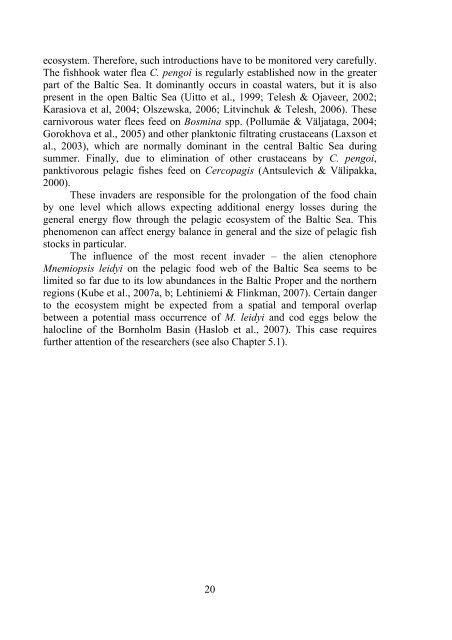Zooplankton of the open Baltic: Extended Atlas - IOW
Zooplankton of the open Baltic: Extended Atlas - IOW
Zooplankton of the open Baltic: Extended Atlas - IOW
Create successful ePaper yourself
Turn your PDF publications into a flip-book with our unique Google optimized e-Paper software.
ecosystem. Therefore, such introductions have to be monitored very carefully.<br />
The fishhook water flea C. pengoi is regularly established now in <strong>the</strong> greater<br />
part <strong>of</strong> <strong>the</strong> <strong>Baltic</strong> Sea. It dominantly occurs in coastal waters, but it is also<br />
present in <strong>the</strong> <strong>open</strong> <strong>Baltic</strong> Sea (Uitto et al., 1999; Telesh & Ojaveer, 2002;<br />
Karasiova et al, 2004; Olszewska, 2006; Litvinchuk & Telesh, 2006). These<br />
carnivorous water flees feed on Bosmina spp. (Pollumäe & Väljataga, 2004;<br />
Gorokhova et al., 2005) and o<strong>the</strong>r planktonic filtrating crustaceans (Laxson et<br />
al., 2003), which are normally dominant in <strong>the</strong> central <strong>Baltic</strong> Sea during<br />
summer. Finally, due to elimination <strong>of</strong> o<strong>the</strong>r crustaceans by C. pengoi,<br />
panktivorous pelagic fishes feed on Cercopagis (Antsulevich & Välipakka,<br />
2000).<br />
These invaders are responsible for <strong>the</strong> prolongation <strong>of</strong> <strong>the</strong> food chain<br />
by one level which allows expecting additional energy losses during <strong>the</strong><br />
general energy flow through <strong>the</strong> pelagic ecosystem <strong>of</strong> <strong>the</strong> <strong>Baltic</strong> Sea. This<br />
phenomenon can affect energy balance in general and <strong>the</strong> size <strong>of</strong> pelagic fish<br />
stocks in particular.<br />
The influence <strong>of</strong> <strong>the</strong> most recent invader – <strong>the</strong> alien ctenophore<br />
Mnemiopsis leidyi on <strong>the</strong> pelagic food web <strong>of</strong> <strong>the</strong> <strong>Baltic</strong> Sea seems to be<br />
limited so far due to its low abundances in <strong>the</strong> <strong>Baltic</strong> Proper and <strong>the</strong> nor<strong>the</strong>rn<br />
regions (Kube et al., 2007a, b; Lehtiniemi & Flinkman, 2007). Certain danger<br />
to <strong>the</strong> ecosystem might be expected from a spatial and temporal overlap<br />
between a potential mass occurrence <strong>of</strong> M. leidyi and cod eggs below <strong>the</strong><br />
halocline <strong>of</strong> <strong>the</strong> Bornholm Basin (Haslob et al., 2007). This case requires<br />
fur<strong>the</strong>r attention <strong>of</strong> <strong>the</strong> researchers (see also Chapter 5.1).<br />
20

















